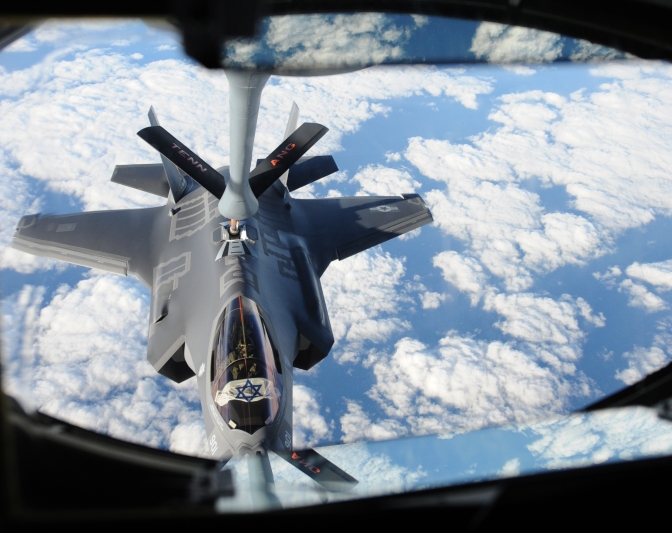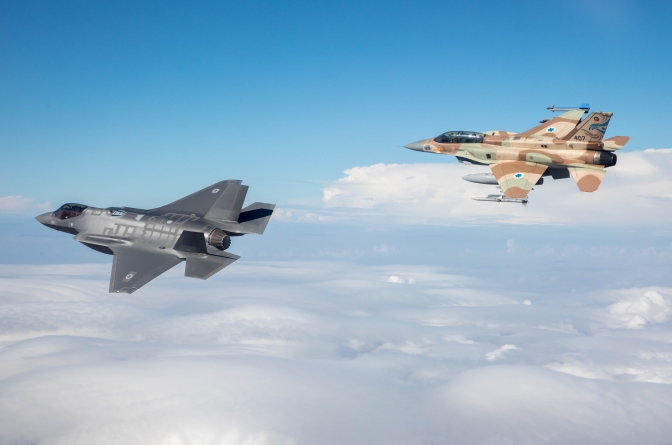According to French newspaper Le Figaro, Israel has already put its tiny F-35 Lightning II fleet to use as early as mid-January of this year, having only taken full delivery of the first F-35s in their 75-strong order in mid-December of last year. Reporter Georges Malbrunot, Le Figaro‘s Middle East correspondent, the F-35’s supposed initial foray into combat occurred in the late night/early morning hours of January 12-13 in an airstrike on Mezzeh Military Airport, Syria, where facilities housing surface-to-air missiles destined for use with Hezbollah, an Islamist terror organization based in Lebanon.
Indeed, Mezzeh, located just outside of Damascus, has been the frequent target of Israeli strikes over the past four months. Claims cross between Israel using both aircraft and surface-to-surface missiles to attack the site,and the Israeli government has admitted to carrying out occasional strikes in Syria to deny the transfer of weaponry to Lebanon, where Hezbollah would likely attempt to use said arms to attack Israel, as it has done in the past. News reports indicate that the particular strike Malbrunot says was perpetrated by the F-35 did actually take place, and in the video footage below, you can see some of the hangars at Mezzeh exploding after being hit. At the time, the Syrian Army (which remains in control of Mezzeh) stated that the attack was actually a rocket strike. However, in the background, what sounds like very faint jet noise can be heard briefly before and after the explosions until it fades away altogether.
VIDEO: Alleged footage of airstrikes against Mezzeh airport in Damascus #Syria. – @AlbinSzakola pic.twitter.com/JzJQc59sVs
— Conflict News (@Conflicts) January 13, 2017
Sometime during or after the attack, the aircraft in the Israeli strike flight apparently flew over Syrian president Bashar Al-Assad’s residence, and carried out a secondary strike nearby, destroying S-300 surface-to-air missile emplacements on Mount Qassioun guarding Al-Assad’s compound. Malbrunot’s source is an anonymous official within France’s foreign intelligence system, the Directorate-General for External Security (DGSE).
Just how accurate are these claims, though?

For one, Israel, at the time, only had just two F-35Is in their possession, having flown them over from Dallas, Texas where they were built in December of last year. These F-35s, serial numbers AS-1/901 and AS-2/02, have been based at Nevatim Airbase with the Israeli Air Force’s 140 Squadron. Ever since the IAF received their first F-35Is, known as “Adirs” (Hebrew for “awesome” or “mighty one”), they’ve been flying and training in tandem with F-16I Fighting Falcons (known as “Sufa” in Israel). It seems highly unlikely that the IAF’s top officers would have been willing to risk deploying one (or both) of their two F-35s on such a combat operation, especially considering that these two initial airframes have generally only been used for training and testing purposes thus far, in order to get IAF fighter pilots up to speed on the Adir, both in flying it and in operating side-by-side with it in other fighter types. Israel is also still in the process of building up the infrastructure and support systems it will need to utilize the F-35I on a long-term basis.

If the F-35I did actually carry out its first combat mission, which is still very difficult to believe, it would be the second fifth-generation fighter to make its combat debut over Syria, after the F-22 Raptor in late 2014. The F-22 also participated in air-to-ground strikes, carried out at nighttime. US Air Force officials touted the Raptor’s stealthiness and radar-evading technologies as being the primary reason behind the advanced multirole air superiority fighter’s deployment to the skies over Syria.
Conversely, “combat testing” isn’t actually unheard of at all. In fact, the US Air Force did just that with the General Dynamics F-111A Aardvark between March and November, 1968, when it deployed six F-111As to Southeast Asia as part of the Combat Lancer test plan. By the end of Combat Lancer, three aircraft were lost, though not due to enemy action but rather, mechanical failure. Eventually, the Aardvark would return to Vietnam in 1972 with a significantly higher combat mission success rate (4000 missions, with only six aircraft lost). That being said, such testing with modern fighter aircraft has been altogether unheard of since. There does remain the possibility that the threat perceived by Israeli defense officials was so severe, that utilizing the F-35I so early on did become a viable option, given its stealth capabilities. Also keeping in mind the alleged existence of a S-300 anti-aircraft missile site in the area, using the F-35I would have been much more preferable to using older fourth generation fighters which don’t possess the advanced radar and sensor-defeating technologies built into the F-35. Lastly, it should be noted that Israel has been known to carry out preemptive strikes to mitigate potential threats over the past forty-odd years or so. Therefore, attacks like these aren’t unquestionably odd or unusual.
It seems pretty implausible that the F-35I was used in the airstrikes on Mezzeh in mid-January, though a case can also be successfully argued for their involvement as well. But until further evidence and information arises that proves that the F-35 was actually deployed by the IAF beyond a reasonable doubt, these claims shouldn’t be viewed in any way as gospel truth.

Taking out an S-300 battery, or multiple batteries? F-35, mos’ def. The 300’s are not the 400’s, but they’re still deadly.
If the batteries were destroyed, it was either rockets or an F-35, and if it were rockets, we’d have heard about it on regular news because of the launches.
LikeLike
The problem is, we don’t know much about the S-300 strike. We know for certain that the airfield was hit and decimated, and for good measure, the IAF did it again with F-15s in late February too. As soon as more info comes to light, which I’m sure it will, I’ll update the article. Following your logic (which I agree with), I doubt the Israelis would want to risk F-15s or F-16s against S-300s in that kind of an environment.
LikeLike
Ferrari
LikeLike
COMING SOON THE IDF-AF F-35A IS CLASSIFIED COMBAT READY. NOT HIS AMERICAN COUNTERPART.
LikeLike
Ferrari
LikeLike